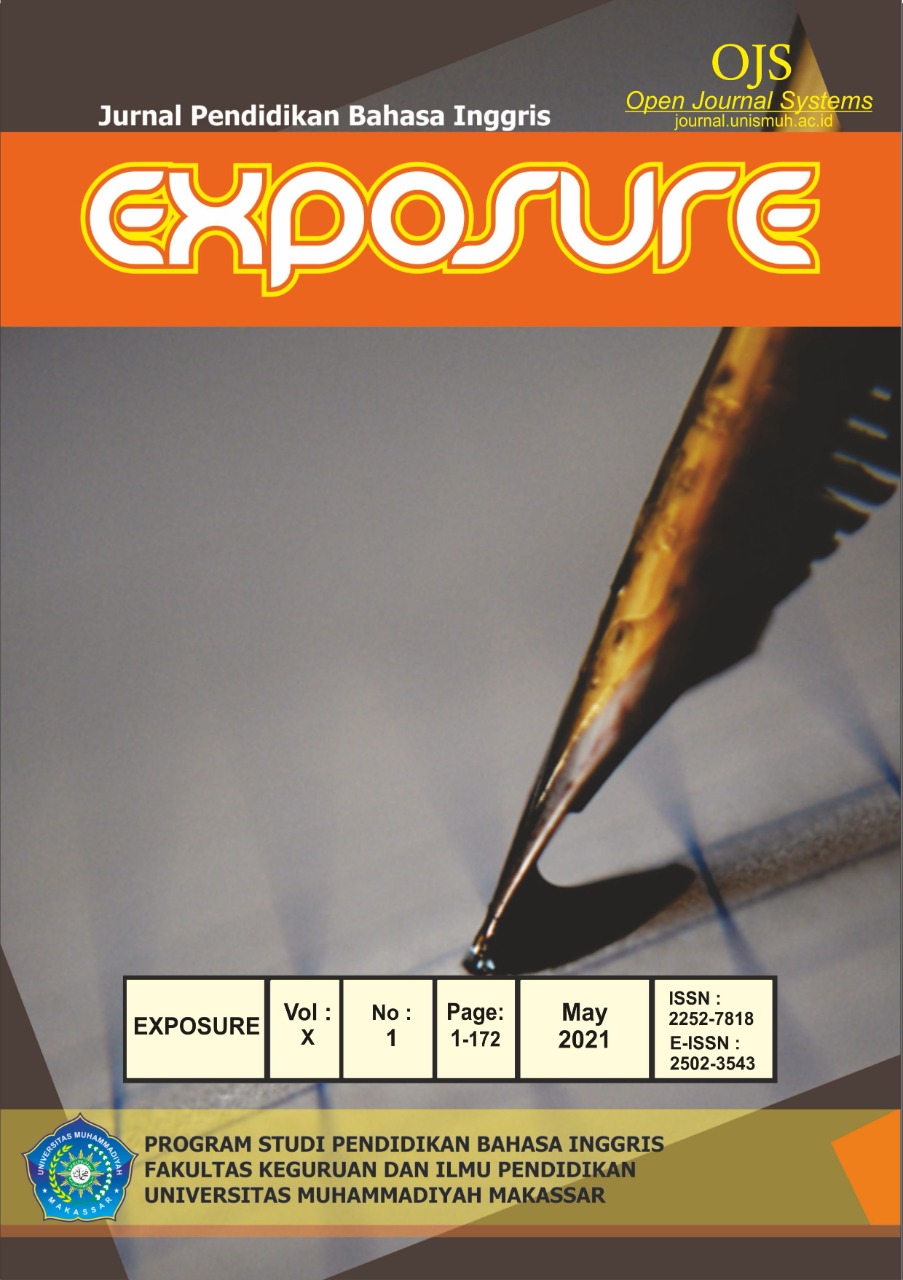THE USE OF TONGUE TWISTER TECHNIQUE TO IMPROVE STUDENTS’ PRONUNCIATION
DOI:
https://doi.org/10.26618/exposure.v10i1.4297Keywords:
Tongue Twister, Pronunciation Teaching Technique, SoundsAbstract
The objective of this research was to find out whether the use of tongue twister technique can improve students’ pronunciation especially in pronouncing sound /ð/, /d/, /θ/, /t/, /ᶴ/, and /s/ or not.The method of this research was pre-experimental with pre-test and post-test as an instrument of the research. The population of the research was the eleventh grade of SMP 2 Sungguminasa that consisted of 63 students. The number of samples was 33 students. The data collection consisted of pre-test, treatment and post-test. Forms of pre-test and post-test were oral test that contained 18 words that related with the focus sounds.The findings of the research showed that the students’ mean score of pre-test before treatment was 63.09%. While after treatment, the mean score of post-test was 86.81%. Therefore, the significant between pre-test and post-test was 37.59%. In order that, the researcher assumed that using tongue twister technique could improve students’ pronunciation correctly especially in pronouncing sound /ð/, /d/, /θ/, /t/, /ᶴ/, and /s/.
References
Bailey, K. &. (1994). New Ways in Teaching Speaking. Illionis: TESOL Inc.
Douidi, M. A. (2016, May). The Effect of Using English Dictionaries on Students' Pronunciation. Retrieved December 9, 2018, from Mohamed Kheider University of Briska: http://dspace.univ-biskra.dz
Gay, L. (1981). Educational Research (Competencies for Analysis and Applications). Columbus: Merril.
Gonzales, N. (2009). Retrieved September 8, 2019, from Learning English with Tongue Twister: jurnal.unmuhjember.ac.id
Huda, M. (2014). Improving Pronuncciation by Using Video Media to the VIIA Students of SMPN 1 Sukomoro. Retrieved December 8, 2018, from State Islamic College of Ponorogo: http://infopapunada.blogspot.com
Iryani, T. (2015, January 5). Semarang State University. Retrieved January 27, 2019, from Improving Fifth Graders’ Pronunciation of “TH” by Using Tongue Twisters: http://lib.unnes.ac.id
Kemendikbud. (1986). Petunjuk Pelaksanaan Praktek Belajar Mengajar dan Petunjuk Penelitian. Jakarta.
Lutfiani, D. &. (2017). Using Tongue Twister to Improve Students’ Pronunciation. Journal of English Language, Literature, and Teaching, 111.
Partners, W. (2012). The Benefits of Tongue Twister in Speech Therapy. Retrieved January 29, 2019, from http://teachingenglish.org.uk
Rohman, M. (2016). The Use of Tongue Twister Technique to Improve EFL Students' Pronunciation. Retrieved January 2, 2019, from Walisongo State Islamic University: http://eprints.walisongo.ac.id
Downloads
Published
Issue
Section
License
Authors who publish with this journal agree to the following terms:
In order to assure the highest standards for published articles, a peer review policy is applied. In pursue of the compliance with academic standards, all parties involved in the publishing process (the authors, the editors and the editorial board and the reviewers) agree to meet the responsibilities stated below in accordance to the Journal publication ethics and malpractice statement.
Duties of Authors:
- The author(s) warrant that the submitted article is an original work, which has not been previously published, and that they have obtained an agreement from any co-author(s) prior to the manuscript’s submission;
- The author(s) should not submit articles describing essentially the same research to more than one journal;
- The authors(s) make certain that the manuscript meets the terms of the Manuscript Submission Guideline regarding appropriate academic citation and that no copyright infringement occurs;
- The authors(s) should inform the editors about any conflict of interests and report any errors they subsequently, discover in their manuscript.
Duties of Editors and the Editorial Board:
- The editors, together with the editorial board, are responsible for deciding upon the publication or rejection of the submitted manuscripts based only on their originality, significance, and relevance to the domains of the journal;
- The editors evaluate the manuscripts compliance with academic criteria, the domains of the journal and the guidelines;
- The editors must at all times respect the confidentiality of any information pertaining to the submitted manuscripts;
- The editors assign the review of each manuscript to two reviewers chosen according to their domains of expertise. The editors must take into account any conflict of interest reported by the authors and the reviewers.
- The editors must ensure that the comments and recommendations of the reviewers are sent to the author(s) in due time and that the manuscripts are returned to the editors, who take the final decision to publish them or not.
Authors are permitted and encouraged to post online a pre-publication manuscript (but not the Publisher’s final formatted PDF version of the Work) in institutional repositories or on their Websites prior to and during the submission process, as it can lead to productive exchanges, as well as earlier and greater citation of published work (see The Effect of Open Access). Any such posting made before acceptance and publication of the Work shall be updated upon publication to include a reference to the Publisher-assigned DOI (Digital Object Identifier) and a link to the online abstract for the final published Work in the Journal.

